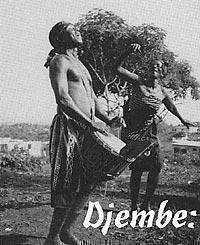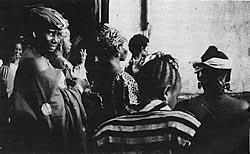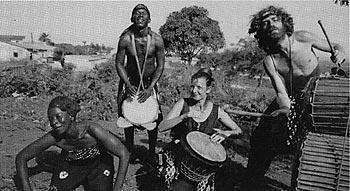 | ||
Thank you to all who supported the Famoudou Konaté workshops from 2000 through 2004. Highlights from all 4 North American tours are coming soon. | ||
from Percussive Notes, the Journal of the Percussive Arts Society, Vol. 31 #8, December 1993 Photo above: Famoudou Konaté and Fanta Kaba IT BELLOWS, SCREECHES, CRIES AND screams. It whispers and it sings. The penetrating depth of its bass and the piercing clarity of its slaps are testimony to the richness of its tale. It is the drum with infinite range, the drum with a thousand faces, each exuding its own unique tenor. This grail-shaped hand drum, known to various tribes in West Africa as the "djembe," (jem-bay) is central to the musical heritage of the Malinke and Sousou tribes of Guinea in West Africa. The common cultural and historical roots of these tribes can be traced to the great Mali Empire which once encompassed all of present-day Mali as well as most of the coastal regions of West Africa. Its legacy has been preserved throughout the centuries in the praises, lamentations and narrations of a special breed of musicians called "griot." Traveling the countryside accompanying themselves on the sacred "kora," a harplike stringed instrument, they give voice to the cultural wisdoms and historical truths of the descendants of Sundiata, the great warrior of the Mali Empire. They enjoy the special status granted them as historical custodians or, as Guinean author Camara Laye has put it, as "guardians of the word."
While the djembe is not necessarily an integral component of the "Griot tradition, it has always played a significant role in the celebration of sacred and secular events among the Malinke and Sousou tribes. Unlike the "talking drums" common to many African traditions, the djembe does not speak by reproducing sounds which correspond to the words of any given language. Instead, it tells its tale in abstract terms that might mean different things to different people. The secret to its seemingly endless spectrum rests, on the surface at least, in the tautness and thickness (relative to the drum body) of the goatskin covering its head. An experienced djembe drummer can coax enough sound from the drum to make it seem like an exchange between several drums is taking place, when in fact just one drum is speaking. And yet, the true complexity and beauty of this tradition lies in the fascinating interplay between the three accompanying bass drums called, in the Malinke tongue, "doundoun" (better known in the United States perhaps as "djundjun" or "junjun"), "sangban" and "kenkeni." These double-headed stick drums, covered at each end with a thick cowhide, form the foundation upon which the djembe can build its solo, which is to say, tell its tale. A bell is hung from each of the three drums which is struck with the left hand while the right hand strikes the cowhide head with a wooden stick. The amalgamation of the two rhythms produced in this manner forms one coherent melody. In a complete ensemble, six independent rhythms (3 bells and 3 hides) intermingle to create a space in which the djembe can weave with vigorous insistence a tapestry of sound. The success of the symphony is dependent not as much on the skill of the djembe soloist as it is on the harmonious interaction between the drums on several levels:
A tense surge of movement and sound is experienced as the djembe leads the ensemble into the "echauffement" (French for 'heating up'). In response to a signal given by the djembe, the entire ensemble bursts into a cacophonous flurry of organized chaos until finally, the djembe gives the signal to return to the original "grooved" or repeating pattern of rhythmic motion.
Perhaps one of the greatest djembe virtuosos known to the western world is Famoudou Konaté of Guinea. Konaté spent the first 20 years of his life as a farmer in the village of Sangbarala near Kouroussa in Guinea. He was the "village drummer" and performed his magic at local festivities. At the approximate age of 20 (in most parts of Africa, it is not customary to count years of a person's life in the precise manner familiar to most western societies), Konaté left his home in the Hamana region surrounding Kourroussa to pursue his drumming career professionally in the capital city of Conakry. There he joined what is perhaps the most highly acclaimed drum and dance ensemble in Africa, "Les Ballets Africains." For 27 years he toured with this, the national ballet of Guinea, as its first solist. In 1987, Konaté teamed up with Fanta Kaba, former director of the dance troupe, to form his own ensemble in Europe. Joined by his most promising and talented white students, Silvia Kronewald, Paul Engel and Viktor Gockler of Berlin who had already established their reputations as drummers par excellence in the "Djembe TUBABU" formation, Konaté became a sensation in his own right with the "Famoudou Konaté Ensemble." Partly due to the group's success in Europe, the djembe has rapidly gained popularity there and numerous ensembles consisting of professional drummers both black and white, have been formed which currently work as forces keeping the powerful and moving tradition of the djembe alive. 1993 Bio: Lilian Friedberg is a performing artist/ drummer/ speaker/ writer of Native American descent currently living in northern Wisconsin. During the eight years she spent abroad, she was able to study with Konaté and his ensemble as well as other such djembe masters as Alseny Camara (Le Ballets Djolibal Conakry) and Soungalou Coulibally (Mali). In 1989 and again in 1991, she traveled to Konaté's home in Conakry to experience first hand a culture she had long observed from afar. At present she seeks to promote and preserve the cultural-spiritual-artistic values and traditions of indigenous peoples and to assist in establishing a community of drummers drumming and dancing to the beat of a dream different from what has been dubbed "the American dream." LILIAN FRIEDBERG'S CURRENT BIOGRAPHY | BACK TO LILIAN'S DRUM WRITINGS INDEX | BACK TO FAMOUDOU KONATÉ PRESS CLIPPINGS | ||
This site is maintained by Famoudou Konaté's North American Managers from 1999-2004,
THE CHICAGO DJEMBE PROJECT: Lilian Friedberg &
Jim Banks,
2849 E. 93rd St. Chicago, IL 60617
t: 773-251-8067
Click to e-mail us at manager @chidjembe.com
Past and current contents of this site ©1999-2012 the Chicago Djembe Project. May not be re-used or reprinted in any form without permission.



